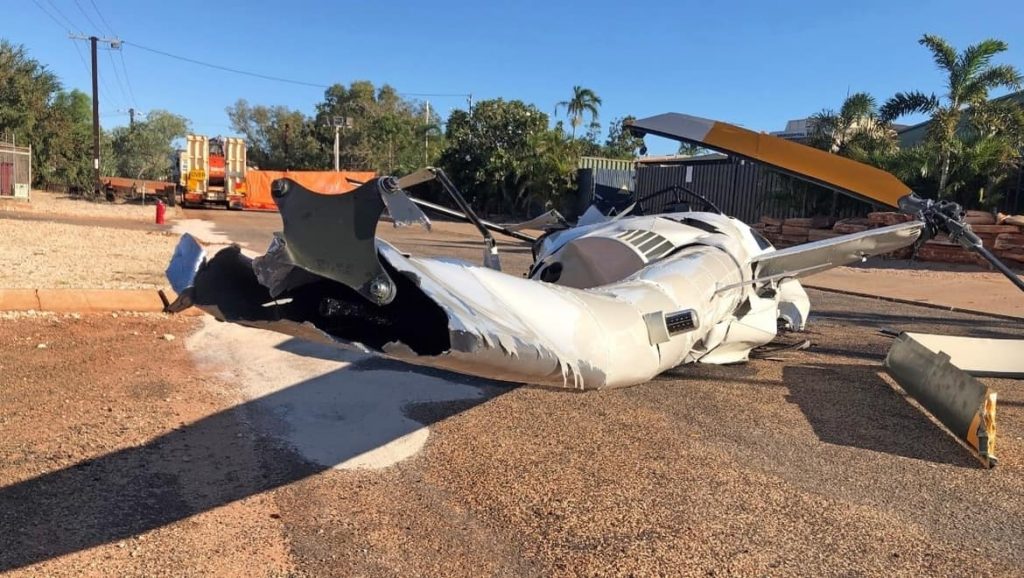
The ATSB is asking for those in the industry with knowledge of defects and damage to parts on Robinson R22, R44 and R66 helicopters to help its investigation into a fatal crash in 2020.
Two of the four people on board the R44 Raven I were killed when it broke up in-flight shortly after departure in Broome, WA, on 4 July 2020, but the exact cause of the breakup is still to be determined.
When the helicopter reached 55 ft, CCTV footage shows that the aircraft’s aft tail cone bulkhead, empennage, tail rotor gearbox, and tail rotor assembly all separated from the helicopter in the space of one second.
In the preliminary report into the incident, the ATSB said a “vibration” in the tail rotor pedals was reported by both the pilot and the owner of the aircraft in the days leading up to the incident, which was subsequently investigated by engineers.
The ATSB also noted a section of the R44’s pilot’s operating handbook that suggests the aircraft could be prone to an “impending failure of a critical component”, indicated by a sound or vibration in-flight. It is not clear whether there were any vibrations present at the time of the fatal flight.
An X-ray of the aircraft’s tail rotor gearbox showed no evidence of internal damage, according to the preliminary report, and the safety bureau has since been working with overseas partners to better understand “similar occurrences” elsewhere.
As the investigation continues, the ATSB is now requesting the assistance of pilots, operators and engineers with knowledge of the aft tail cone bulkhead or tail rotor gearbox input cartridge damage involving Robinson R22, R44 and R66 helicopters.
Since the accident, the ATSB has undertaken “extensive and ongoing metallurgical examination and analysis” of the airframe and tail rotor components, including examining other R44 helicopter tail rotor gearboxes, components and bulkhead castings.
“Due to the disruptive nature of the accident, this examination and analysis may not reveal a specific point of failure in the helicopter,” said the ATSB’s director of transport safety, Dr Mike Walker.
“Indeed, in similar accidents overseas, despite extensive materials analysis, contributing factors have not been identified.”
Dr Walker said the ATSB has been working closely with the manufacturer, the US National Transportation Safety Board and the UK Air Accidents Investigations Branch to better understand this and similar accidents involving the R44 helicopter, and was now seeking the assistance of the industry.
Regulations under the Transport Safety Investigation Act 2003 require the ATSB to be notified of damage sustained from when an aircraft is being prepared for flight until it has landed and passengers and crew have disembarked, but not for damage sustained during ground handling.
“There may have been events during ground handling resulting in damage to Robinson helicopters that were not required to be reported to the ATSB,” explained Dr Walker.
“As a result, industry may be aware of information that could significantly aid the ATSB’s investigation.”
Any information provided to the ATSB that could assist the investigation would be protected as evidence under the Transport Safety Investigation Act 2003, Dr Walker noted.
“If damaged components are available, we may seek to recover these for examination,” he said.
The context of the occurrence and the results of ATSB’s analysis will be published in the final report at the conclusion of the investigation.
“At this point in the investigation, it is important to stress that the ATSB has not determined that this helicopter sustained ground handling damage, nor that damage while ground handling contributed to this accident,” Dr Walker stated.
















chris
says:Sounds as though they are fairly sure she sustained damage whilst being ground handled. Helos are delicate…
David Wearne
says:The type of flexible drive joints employed on the tail rotor drive shaft are not considered to be constant velocity joints and would cause angular acceleration and deceleration if any difference in the angles of each joint or a difference in the planes of each angle existed either from new or from distortion or incorrect assembly. These rotational speed variations can cause torsional load variations (vibrations) and could resonate at certain speeds with various components including especially the tail rotor gearbox mountings and airframe in the area due to the relatively much heavier and more stable nature of the drive from the main rotor gear box.